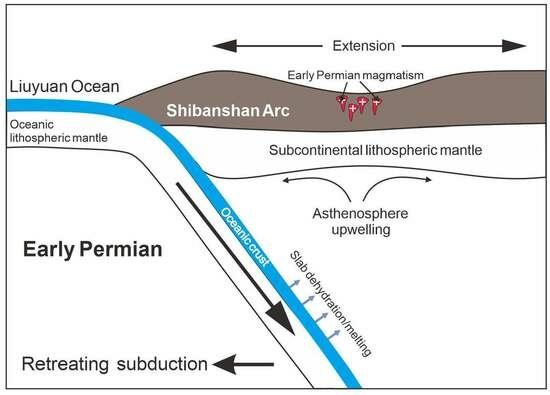Petrogenesis and Tectonic Significance of Early Permian Intermediate–Felsic Rocks in the Southern Beishan Orogen, Northwest China: Geochronological and Geochemical Constraints
Abstract
:1. Introduction
2. Geological Background and Description of Samples
2.1. Geological Background
2.2. Description of Samples
3. Analytical Methods
3.1. Zircon U-Pb and Lu-Hf Isotopic Analyses
3.2. Whole-Rock Major and Trace Elements
3.3. Whole-Rock Sr-Nd Isotopic Analyses
4. Analytical Results
4.1. Zircon U–Pb Ages and Lu-Hf Isotope Compositions
4.2. Whole-Rock Major and Trace Element Geochemistry
4.3. Whole-Rock Sr-Nd Isotope Compositions
5. Discussion
5.1. Petrogenesis
5.1.1. The Northern Qingshan Diorites
5.1.2. The Heishantou Quartz Diorites
5.1.3. The Southern Qingshan Biotite Granodiorites
5.2. Implications for the Early Permian Geodynamic Setting in the Southern Beishan
6. Conclusions
- (1)
- Intermediate–felsic igneous rocks are widespread in the Shibanshan unit, the southernmost end of the Beishan orogen. New LA–ICP–MS zircon U–Pb results reveal ages of 300 Ma for the northern Qingshan diorites, 294 Ma for the Heishantou quartz diorites, and 291–286 Ma for the southern Qingshan biotite granodiorites. The diorites were likely sourced from an enriched mantle influenced by subduction fluids and/or melts. The quartz diorites originated from the partial melting of the juvenile lower crustal rocks with input from the enriched mantle. The biotite granodiorites are I-type granitoids and originated from a mixing process between the enriched mantle-derived and preexisting juvenile lower crust-derived magmas.
- (2)
- The early Permian intermediate–felsic rocks exhibit geochemical signatures of arc magmatism, and their generation involved subduction-related materials. Different magma components, including the enriched mantle and juvenile lower crust, participated in the generation of these rocks, implying a strong interaction between crustal- and mantle-derived magmas. Additionally, all analyzed zircons in this study exhibit trace element characteristics typical of continental arc-type zircons. In conjunction with previous studies, we infer that an early Permian retreating subduction of the Liuyuan Ocean developed in the Shibanshan unit, the southernmost part of the Beishan orogen. Moreover, the Beishan orogen likely experienced multiple accretionary–collisional processes during the Paleozoic.
Supplementary Materials
Author Contributions
Funding
Data Availability Statement
Acknowledgments
Conflicts of Interest
References
- Sengör, A.M.C.; Natalin, B.A.; Burtman, V.S. Evolution of the Altaid tectonic collage and Palaeozoic crustal growth in Eurasia. Nature 1993, 364, 299–307. [Google Scholar] [CrossRef]
- Jahn, B.M.; Wu, F.Y.; Chen, B. Granitoids of the Central Asian Orogenic Belt and continental growth in the Phanerozoic. Trans. R. Soc. Edinb. Earth Sci. 2000, 91, 181–193. [Google Scholar] [CrossRef]
- Xiao, W.J.; Windley, B.F.; Sun, S.; Li, J.L.; Huang, B.C.; Han, C.M.; Yuan, C.; Sun, M.; Chen, H.L. A Tale of Amalgamation of Three Permo-Triassic Collage Systems in Central Asia: Oroclines, Sutures, and Terminal Accretion. Annu. Rev. Earth Planet. Sci. 2015, 43, 477–507. [Google Scholar] [CrossRef]
- Wang, T.; Xiao, W.J.; Collins, W.; Tong, Y.; Hou, Z.Q.; Huang, H.; Xiaoxia, W.; Lin, S.F.; Seltmann, R.; Wang, C.Y.; et al. Quantitative characterization of orogens through isotopic mapping. Commun. Earth Environ. 2023, 4, 110. [Google Scholar] [CrossRef]
- Yakubchuk, A.S.; Shatov, V.V.; Kirwin, D.; Edwards, A.; Tomurtogoo, O.; Badarch, G.; Buryak, V.A. Gold and base metal metallogeny of the Central Asian orogenic supercollage. In Economic Geology 100th Anniversary Volume; Hedenquist, J.W., Thompson, J.F.H., Goldfarb, R.J., Richards, J.P., Eds.; Society of Economic Geologists: Littleton, CO, USA, 2005; pp. 1035–1068. [Google Scholar]
- Gao, J.; Klemd, R.; Zhu, M.; Wang, X.; Li, J.; Wan, B.; Xiao, W.; Zeng, Q.; Shen, P.; Sun, J.; et al. Large-scale porphyry-type mineralization in the Central Asian metallogenic domain: A review. J. Asian Earth Sci. 2018, 165, 7–36. [Google Scholar] [CrossRef]
- Heinhorst, J.; Lehmann, B.; Ermolov, P.; Serykh, V.; Zhurutin, S. Paleozoic crustal growth and metallogeny of Central Asia: Evidence from magmatic-hydrothermal ore systems of Central Kazakhstan. Tectonophysics 2000, 328, 69–87. [Google Scholar] [CrossRef]
- Xiao, W.J.; Mao, Q.G.; Windley, B.F.; Han, C.M.; Qu, J.F.; Zhang, J.E.; Ao, S.J.; Guo, Q.Q.; Cleven, N.R.; Lin, S.F. Paleozoic multiple accretionary and collisional processes of the Beishan orogenic collage. Am. J. Sci. 2010, 310, 1553–1594. [Google Scholar] [CrossRef]
- Metcalfe, I. Multiple Tethyan ocean basins and orogenic belts in Asia. Gondwana Res. 2021, 100, 87–130. [Google Scholar] [CrossRef]
- Wu, F.y.; Wan, B.; Zhao, L.; Xiao, W.J.; Zhu, R.X. Tethyan geodynamics. Acta Petrol. Sin. 2020, 36, 1627–1674, (In Chinese with English abstract). [Google Scholar]
- Wang, X.Y. The Rock Assemblages, Spatial and Temporal Variations in the Gongpoquan Arc, Beishan and Their Implications for Tectonic Setting. Ph.D. Thesis, Guangzhou Institute of Geochemistry, GAS, Guangzhou, China, 2017; 149p. [Google Scholar]
- Yuan, Y. The Continental Crust Formation and Evolution of the Beishan Orogenic Belt. Ph.D. Thesis, China University of Geosciences, Wuhan, China, 2019; 255p. [Google Scholar]
- Zheng, R.G.; Xiao, W.J.; Li, J.Y.; Wu, T.R.; Zhang, W. A Silurian-early Devonian slab window in the southern Central Asian Orogenic Belt: Evidence from high-Mg diorites, adakites and granitoids in the western Central Beishan region, NW China. J. Asian Earth Sci. 2018, 153, 75–99. [Google Scholar] [CrossRef]
- Song, D.F.; Xiao, W.J.; Windley, B.F.; Han, C.M.; Tian, Z.H. A Paleozoic Japan-type subduction-accretion system in the Beishan orogenic collage, southern Central Asian Orogenic Belt. Lithos 2015, 224–225, 195–213. [Google Scholar] [CrossRef]
- Wang, E.; Zhai, X.; Chen, W.; Wu, L.; Song, G.; Wang, Y.; Guo, Z.; Zhao, J.; Wang, J. Late Devonian A-Type Granites from the Beishan, Southern Central Asia Orogenic Belt: Implications for Closure of the Paleo-Asia Ocean. Minerals 2023, 13, 565. [Google Scholar] [CrossRef]
- Zheng, R.G.; Li, J.Y.; Zhang, J.; Xiao, W.J.; Wang, Q.J. Permian oceanic slab subduction in the southmost of Central Asian Orogenic Belt: Evidence from adakite and high-Mg diorite in the southern Beishan. Lithos 2020, 358, 105406. [Google Scholar] [CrossRef]
- Mao, Q.G.; Xiao, W.J.; Windley, B.F.; Han, C.M.; Qu, J.F.; Ao, S.J.; Zhang, J.E.; Guo, Q.Q. The Liuyuan complex in the Beishan, NW China: A Carboniferous–Permian ophiolitic fore-arc sliver in the southern Altaids. Geol. Mag. 2012, 149, 483–506. [Google Scholar] [CrossRef]
- Su, B.-X.; Qin, K.-Z.; Sakyi, P.A.; Li, X.-H.; Yang, Y.-H.; Sun, H.; Tang, D.-M.; Liu, P.-P.; Xiao, Q.-H.; Malaviarachchi, S.P.K. U–Pb ages and Hf–O isotopes of zircons from Late Paleozoic mafic–ultramafic units in the southern Central Asian Orogenic Belt: Tectonic implications and evidence for an Early-Permian mantle plume. Gondwana Res. 2011, 20, 516–531. [Google Scholar] [CrossRef]
- Zhang, W.; Wu, T.; Zheng, R.; Feng, J.; Luo, H.; He, Y.; Xu, C. Post-collisional Southeastern Beishan granites: Geochemistry, geochronology, Sr–Nd–Hf isotopes and their implications for tectonic evolution. J. Asian Earth Sci. 2012, 58, 51–63. [Google Scholar] [CrossRef]
- Niu, Y.Z.; Shi, G.R.; Wang, J.Q.; Liu, C.Y.; Zhou, J.L.; Lu, J.C.; Song, B.; Xu, W. The closing of the southern branch of the Paleo-Asian Ocean: Constraints from sedimentary records in the southern Beishan Region of the Central Asian Orogenic Belt, NW China. Mar. Pet. Geol. 2021, 124, 104791. [Google Scholar] [CrossRef]
- Moyen, J.F.; Laurent, O.; Chelle-Michou, C.; Couzinié, S.; Vanderhaeghe, O.; Zeh, A.; Villaros, A.; Gardien, V. Collision vs. subduction-related magmatism: Two contrasting ways of granite formation and implications for crustal growth. Lithos 2017, 277, 154–177. [Google Scholar] [CrossRef]
- Marxer, F.; Ulmer, P.; Müntener, O. Polybaric fractional crystallisation of arc magmas: An experimental study simulating trans-crustal magmatic systems. Contrib. Mineral. Petrol. 2021, 176, 3. [Google Scholar] [CrossRef]
- Barbarin, B. Mafic magmatic enclaves and mafic rocks associated with some granitoids of the central Sierra Nevada batholith, California: Nature, origin, and relations with the hosts. Lithos 2005, 80, 155–177. [Google Scholar] [CrossRef]
- DePaolo, D.J. Trace element and isotopic effects of combined wallrock assimilation and fractional crystallization. Earth Planet. Sci. Lett. 1981, 53, 189–202. [Google Scholar] [CrossRef]
- Webster, J.D. Exsolution of magmatic volatile phases from Cl-enriched mineralizing granitic magmas and implications for ore metal transport. Geochim. Cosmochim. Acta 1997, 61, 1017–1029. [Google Scholar] [CrossRef]
- Charlier, B.; Grove, T.L. Experiments on liquid immiscibility along tholeiitic liquid lines of descent. Contrib. Mineral. Petrol. 2012, 164, 27–44. [Google Scholar] [CrossRef]
- Clemens, J.D.; Stevens, G. What controls chemical variation in granitic magmas? Lithos 2012, 134–135, 317–329. [Google Scholar] [CrossRef]
- Moyen, J.-F.; Janoušek, V.; Laurent, O.; Bachmann, O.; Jacob, J.-B.; Farina, F.; Fiannacca, P.; Villaros, A. Crustal melting vs. fractionation of basaltic magmas: Part 1, granites and paradigms. Lithos 2021, 402–403, 106291. [Google Scholar] [CrossRef]
- Chapman, J.B.; Ducea, M.N.; Kapp, P.; Gehrels, G.E.; DeCelles, P.G. Spatial and temporal radiogenic isotopic trends of magmatism in Cordilleran orogens. Gondwana Res. 2017, 48, 189–204. [Google Scholar] [CrossRef]
- Zhu, D.C.; Wang, Q.; Weinberg, R.; Cawood, P.; Chung, S.L.; Zheng, Y.F.; Zhao, Z.; Hou, Z.Q.; Mo, X.X. Interplay between oceanic subduction and continental collision in building continental crust. Nat. Commun. 2022, 13, 7141. [Google Scholar] [CrossRef]
- Zuo, G.C.; He, G.Q. Plate Tectonics and Metallogenesis Regularities in Beishan Region; Peking University Press: Beijing, China, 1990. [Google Scholar]
- Yang, H.Q.; Li, Y.; Zhao, G.B.; Li, W.Y.; Wang, X.H.; Jiang, H.B.; Tan, W.J.; Sun, N.Y. Character and Structural Attribute of the Beishan Ophiolite. Northwestern Geol. 2010, 43, 26–36, (In Chinese with English abstract). [Google Scholar]
- Mao, Q.G.; Xiao, W.J.; Wang, H.; Ao, S.J.; Windley, B.; Song, D.F.; Sang, M.; Tan, Z.; Li, R.; Wang, M. Prolonged Late Mesoproterozoic to Late Triassic Tectonic Evolution of the Major Paleo-Asian Ocean in the Beishan Orogen (NW China) in the Southern Altaids. Front. Earth Sci. 2022, 9, 825852. [Google Scholar] [CrossRef]
- Santos, G.S.; Bédard, J.; Staal, C.; Lin, S.F.; Hong, T.; Wang, K. Geology of the Liuyuan Complex, NW China: A Permian back-arc basin ophiolite at the southern edge of the Central Asian orogenic belt. Geol. Soc. Am. Bull. 2023, 135, 2830–2848. [Google Scholar] [CrossRef]
- Wang, G.Q.; Li, X.M.; Xu, X.Y.; Yu, J.Y.; Wu, P.; Ji, B. Research status and progress of Paleozoic ophiolites in Beishan orogenic belt. Geol. Bull. China 2021, 40, 71–81, (In Chinese with English abstract). [Google Scholar]
- Song, D.F.; Xiao, W.J.; Windley, B.F.; Han, C.M.; Yang, L. Metamorphic complexes in accretionary orogens: Insights from the Beishan collage, southern Central Asian Orogenic Belt. Tectonophysics 2016, 688, 135–147. [Google Scholar] [CrossRef]
- He, Z.Y.; Klemd, R.; Yan, L.L.; Zhang, Z.M. The origin and crustal evolution of microcontinents in the Beishan orogen of the southern Central Asian Orogenic Belt. Earth-Sci. Rev. 2018, 185, 1–14. [Google Scholar] [CrossRef]
- Zheng, R.; Li, J.; Zhang, J.; Xiao, W. A prolonged subduction-accretion in the southern Central Asian Orogenic Belt: Insights from anatomy and tectonic affinity for the Beishan complex. Gondwana Res. 2021, 95, 88–112. [Google Scholar] [CrossRef]
- Castro, A. Tonalite–granodiorite suites as cotectic systems: A review of experimental studies with applications to granitoid petrogenesis. Earth-Sci. Rev. 2013, 124, 68–95. [Google Scholar] [CrossRef]
- Yu, C.; Yang, Z.M.; Zhou, L.M.; Zhang, L.L.; Li, Z.Q.; Zhao, M.; Zhang, J.Y.; Chen, W.Y.; Suo, M.S. Impact of laser focus on accuracy of U-Pb dating of zircons by LA-ICPMS. Miner. Depos. 2019, 38, 21–28, (In Chinese with English abstract). [Google Scholar]
- Liu, R.; Tong, Y.; Zhang, H.-F.; Duan, S.; Guo, L. Mixing of magmas from multiple sources in the petrogenesis of multi-stage Early Cretaceous syenites in the Wulingshan alkaline complex, northern North China Craton: Evidence from enclaves. Geol. J. 2023, 58, 3063–3086. [Google Scholar] [CrossRef]
- Paton, C.; Woodhead, J.D.; Hellstrom, J.C.; Hergt, J.M.; Greig, A.; Maas, R. Improved laser ablation U-Pb zircon geochronology through robust downhole fractionation correction. Geochem. Geophys. Geosyst. 2010, 11, 1–36. [Google Scholar] [CrossRef]
- Ludwig, K.R. Isoplot 3.00: A Geochronological Toolkit for Microsoft Excel, Berkeley. Geochronol. Cent. Spec. Publ. 2003, 4, 1–74. [Google Scholar]
- Wu, F.Y.; Yang, Y.H.; Xie, L.W.; Yang, J.H.; Xu, P. Hf isotopic compositions of the standard zircons and baddeleyites used in U–Pb geochronology. Chem. Geol. 2006, 234, 105–126. [Google Scholar] [CrossRef]
- Hou, K.J.; Li, Y.H.; Zou, T.R.; Qu, X.M.; Shi, Y.R.; Xie, G.Q. Laser Ablation-MC-ICP-MS technique for Hf Isotope Microanalysis of Zircon and its Geological applications. Acta Petrol. Sin. 2007, 23, 2595–2604, (In Chinese with English abstract). [Google Scholar]
- Söderlund, U.; Patchett, P.J.; Vervoort, J.D.; Isachsen, C.E. The 176Lu decay constant determined by Lu–Hf and U–Pb isotope systematics of Precambrian mafic intrusions. Earth Planet. Sci. Lett. 2004, 219, 311–324. [Google Scholar] [CrossRef]
- Blichert-Toft, J.; Albarède, F. The Lu-Hf isotope geochemistry of chondrites and the evolution of the mantle-crust system. Earth Planet. Sci. Lett. 1997, 148, 243–258. [Google Scholar] [CrossRef]
- Griffin, W.L.; Pearson, N.J.; Belousova, E.; Jackson, S.E.; van Achterbergh, E.; O’Reilly, S.Y.; Shee, S.R. The Hf isotope composition of cratonic mantle: LAM-MC-ICPMS analysis of zircon megacrysts in kimberlites. Geochim. Cosmochim. Acta 2000, 64, 133–147. [Google Scholar] [CrossRef]
- Liu, Y.; Zong, K.; Kelemen, P.B.; Gao, S. Geochemistry and magmatic history of eclogites and ultramafic rocks from the Chinese continental scientific drill hole: Subduction and ultrahigh-pressure metamorphism of lower crustal cumulates. Chem. Geol. 2008, 247, 133–153. [Google Scholar] [CrossRef]
- Savatenkov, V.M.; Kozlovsky, A.M.; Yarmolyuk, V.V.; Rudnev, S.N.; Oyunchimeg, T. Pb and Nd Isotopic Data on Granitoids from the Lake Zone, Mongolian and Gobi Altai with Implications for the Crustal Growth of the Central Asian Orogenic Belt. Petrology 2020, 28, 403–417. [Google Scholar] [CrossRef]
- Chen, F.; Hegner, E.; Todt, W. Zircon ages and Nd isotopic and chemical compositions of orthogneisses from the Black Forest, Germany: Evidence for a Cambrian magmatic arc. Int. J. Earth Sci. 2000, 88, 791–802. [Google Scholar] [CrossRef]
- Chen, F.; Siebel, W.; Satir, M.; Terzioğlu, M.; Saka, K. Geochronology of the Karadere basement (NW Turkey) and implications for the geological evolution of the Istanbul zone. Int. J. Earth Sci. 2002, 91, 469–481. [Google Scholar] [CrossRef]
- Goldstein, S.J.; Jacobsen, S.B. Nd and Sr isotopic systematics of river water suspended material: Implications for crustal evolution. Earth Planet. Sci. Lett. 1988, 87, 249–265. [Google Scholar] [CrossRef]
- Jacobsen, S.B.; Wasserburg, G.J. Sm-Nd isotopic evolution of chondrites and achondrites, II. Earth Planet. Sci. Lett. 1984, 67, 137–150. [Google Scholar] [CrossRef]
- Hoskin, P.W.O. Trace-element composition of hydrothermal zircon and the alteration of Hadean zircon from the Jack Hills, Australia. Geochim. Cosmochim. Acta 2005, 69, 637–648. [Google Scholar] [CrossRef]
- Bell, E.A.; Boehnke, P.; Harrison, T.M. Recovering the primary geochemistry of Jack Hills zircons through quantitative estimates of chemical alteration. Geochim. Cosmochim. Acta 2016, 191, 187–202. [Google Scholar] [CrossRef]
- Yan, W.; Casey, J.F. Synchronous formation of the ‘forearc’ Bay of Islands ophiolite and its basal high-temperature metamorphic sole constrained by U–Pb zircon ages. Geosci. Front. 2023, 14, 101649. [Google Scholar] [CrossRef]
- Grimes, C.B.; Wooden, J.L.; Cheadle, M.J.; John, B.E. “Fingerprinting” tectono-magmatic provenance using trace elements in igneous zircon. Contrib. Mineral. Petrol. 2015, 170, 46. [Google Scholar] [CrossRef]
- Middlemost, E.A.K. Naming materials in the magma/igneous rock system. Earth-Sci. Rev. 1994, 37, 215–224. [Google Scholar] [CrossRef]
- Rickwood, P.C. Boundary lines within petrologic diagrams which use oxides of major and minor elements. Lithos 1989, 22, 247–263. [Google Scholar] [CrossRef]
- Maniar, P.D.; Piccoli, P.M. Tectonic discrimination of granitoids. GSA Bull. 1989, 101, 635–643. [Google Scholar] [CrossRef]
- Shimoda, G.; Tatsumi, Y.; Nohda, S.; Ishizaka, K.; Jahn, B.M. Setouchi high-Mg andesites revisited: Geochemical evidence for melting of subducting sediments. Earth Planet. Sci. Lett. 1998, 160, 479–492. [Google Scholar] [CrossRef]
- Tatsumi, Y.; Shukuno, H.; Sato, K.; Shibata, T.; Yoshikawa, M. The Petrology and Geochemistry of High-Magnesium Andesites at the Western Tip of the Setouchi Volcanic Belt, SW Japan. J. Petrol. 2003, 44, 1561–1578. [Google Scholar] [CrossRef]
- Tatsumi, Y.; Suzuki, T.; Kawabata, H.; Sato, K.; MiyazakiI, T.; Chang, Q.; Takahashi, T.; Tani, K.; Shibata, T.; Yoshikawa, M. The Petrology and Geochemistry of Oto-Zan Composite Lava Flow on Shodo-Shima Island, SW Japan: Remelting of a Solidified High-Mg Andesite Magma. J. Petrol. 2006, 47, 595–629. [Google Scholar] [CrossRef]
- Zheng, R.G.; Li, J.Y.; Xiao, W.J. Mid-Paleozoic ridge subduction in the Central Beishan of the southern Altaids: Evidence from geochemical, Sr-Nd and zircon U-Pb-Hf-O isotopic data of Gongpoquan volcanic rocks. J. Geol. Soc. 2019, 176, 755–770. [Google Scholar] [CrossRef]
- Rapp, R.P.; Watson, E.B.; Miller, C.F. Partial melting of amphibolite/eclogite and the origin of Archean trondhjemites and tonalites. Precambrian Res. 1991, 51, 1–25. [Google Scholar] [CrossRef]
- Rapp, R.P.; Watson, E.B. Dehydration Melting of Metabasalt at 8–32 kbar: Implications for Continental Growth and Crust-Mantle Recycling. J. Petrol. 1995, 36, 891–931. [Google Scholar] [CrossRef]
- Rapp, R.P.; Shimizu, N.; Norman, M.D.; Applegate, G.S. Reaction between slab-derived melts and peridotite in the mantle wedge: Experimental constraints at 3.8 GPa. Chem. Geol. 1999, 160, 335–356. [Google Scholar] [CrossRef]
- Sen, C.; Dunn, T. Dehydration melting of a basaltic composition amphibolite at 1.5 and 2.0 GPa: Implications for the origin of adakites. Contrib. Mineral. Petrol. 1994, 117, 394–409. [Google Scholar] [CrossRef]
- Prouteau, G.; Scaillet, B.; Pichavant, M.; Maury, R.C. Fluid-present melting of ocean crust in subduction zones. Geology 1999, 27, 1111–1114. [Google Scholar] [CrossRef]
- Sun, S.S.; McDonough, W.F. Chemical and isotopic systematics of oceanic basalts: Implications for mantle composition and processes. Geol. Soc. Lond. Spec. Publ. 1989, 42, 313–345. [Google Scholar] [CrossRef]
- Xu, W.; Xu, X.Y.; Niu, Y.Z.; Chen, G.C.; Shi, J.Z.; Wei, J.S.; Song, B.; Zhang, Y.X. Geochronology, petrogenesis and tectonic implications of Early Permian A-type rhyolite from southern Beishan orogen, NW China. Acta Petrol. Sin. 2018, 34, 3011–3033, (In Chinese with English abstract). [Google Scholar]
- Abdel-Karim, A.-A.M.; Azer, M.K.; Mogahed, M.M. Neoproterozoic concentric intrusive complex of gabbro-diorite-tonalite-granodiorite association, Rahaba area, southern Eastern Desert of Egypt: Implications for magma mixing of arc intrusive rocks. Lithos 2021, 404–405, 106423. [Google Scholar] [CrossRef]
- Jung, S.; Hoernes, S.; Mezger, K. Synorogenic melting of mafic lower crust: Constraints from geochronology, petrology and Sr, Nd, Pb and O isotope geochemistry of quartz diorites (Damara orogen, Namibia). Contrib. Mineral. Petrol. 2002, 143, 551–566. [Google Scholar] [CrossRef]
- France, L.; Koepke, J.; Ildefonse, B.; Cichy, S.; Deschamps, F. Hydrous partial melting in the sheeted dike complex at fast spreading ridges: Experimental and natural observations. Contrib. Mineral. Petrol. 2010, 160, 683–704. [Google Scholar] [CrossRef]
- Yang, J.-H.; Wu, F.-Y.; Chung, S.-L.; Wilde, S.A.; Chu, M.-F. Multiple sources for the origin of granites: Geochemical and Nd/Sr isotopic evidence from the Gudaoling granite and its mafic enclaves, northeast China. Geochim. Cosmochim. Acta 2004, 68, 4469–4483. [Google Scholar] [CrossRef]
- Wolf, M.B.; Wyllie, P.J. Dehydration-melting of amphibolite at 10 kbar: The effects of temperature and time. Contrib. Mineral. Petrol. 1994, 115, 369–383. [Google Scholar] [CrossRef]
- Altherr, R.; Holl, A.; Hegner, E.; Langer, C.; Kreuzer, H. High-potassium, calc-alkaline I-type plutonism in the European Variscides: Northern Vosges (France) and northern Schwarzwald (Germany). Lithos 2000, 50, 51–73. [Google Scholar] [CrossRef]
- Stern, C.R.; Kilian, R. Role of the subducted slab, mantle wedge and continental crust in the generation of adakites from the Andean Austral Volcanic Zone. Contrib. Mineral. Petrol. 1996, 123, 263–281. [Google Scholar] [CrossRef]
- Eby, G.N. The A-type granitoids: A review of their occurrence and chemical characteristics and speculations on their petrogenesis. Lithos 1990, 26, 115–134. [Google Scholar] [CrossRef]
- Chauvel, C.; Lewin, E.; Carpentier, M.; Arndt, N.T.; Marini, J.-C. Role of recycled oceanic basalt and sediment in generating the Hf–Nd mantle array. Nat. Geosci. 2008, 1, 64–67. [Google Scholar] [CrossRef]
- Vervoort, J.D.; Plank, T.; Prytulak, J. The Hf–Nd isotopic composition of marine sediments. Geochim. Cosmochim. Acta 2011, 75, 5903–5926. [Google Scholar] [CrossRef]
- Schmidt, M.W.; Jagoutz, O. The global systematics of primitive arc melts. Geochem. Geophys. Geosyst. 2017, 18, 2817–2854. [Google Scholar] [CrossRef]
- Xu, W.; Zhu, D.-C.; Wang, Q.; Weinberg, R.F.; Wang, R.; Li, S.-M.; Zhang, L.-L.; Zhao, Z.-D. Constructing the Early Mesozoic Gangdese Crust in Southern Tibet by Hornblende-dominated Magmatic Differentiation. J. Petrol. 2019, 60, 515–552. [Google Scholar] [CrossRef]
- Cornet, J.; Laurent, O.; Wotzlaw, J.F.; Antonelli, M.A.; Otamendi, J.; Bergantz, G.W.; Bachmann, O. Reworking subducted sediments in arc magmas and the isotopic diversity of the continental crust: The case of the Ordovician Famatinian crustal section, Argentina. Earth Planet. Sci. Lett. 2022, 595, 117706. [Google Scholar] [CrossRef]
- Class, C.; Miller, D.M.; Goldstein, S.L.; Langmuir, C.H. Distinguishing melt and fluid subduction components in Umnak Volcanics, Aleutian Arc. Geochem. Geophys. Geosyst. 2000, 1, 1–28. [Google Scholar] [CrossRef]
- Keller, C.B.; Schoene, B.; Barboni, M.; Samperton, K.M.; Husson, J.M. Volcanic–plutonic parity and the differentiation of the continental crust. Nature 2015, 523, 301–307. [Google Scholar] [CrossRef] [PubMed]
- Schiano, P.; Monzier, M.; Eissen, J.P.; Martin, H.; Koga, K.T. Simple mixing as the major control of the evolution of volcanic suites in the Ecuadorian Andes. Contrib. Mineral. Petrol. 2010, 160, 297–312. [Google Scholar] [CrossRef]
- Huang, H.; Niu, Y.; Mo, X. Garnet effect on Nd-Hf isotope decoupling: Evidence from the Jinfosi batholith, Northern Tibetan Plateau. Lithos 2017, 274–275, 31–38. [Google Scholar] [CrossRef]
- Tang, M.; Wang, X.-L.; Shu, X.-J.; Wang, D.; Yang, T.; Gopon, P. Hafnium isotopic heterogeneity in zircons from granitic rocks: Geochemical evaluation and modeling of “zircon effect” in crustal anatexis. Earth Planet. Sci. Lett. 2014, 389, 188–199. [Google Scholar] [CrossRef]
- Zhang, C.; Liu, D.; Zhang, X.; Spencer, C.; Tang, M.; Zeng, J.; Jiang, S.; Jolivet, M.; Kong, X.Y. Hafnium isotopic disequilibrium during sediment melting and assimilation. Geochem. Perspect. 2020, 12, 34–39. [Google Scholar] [CrossRef]
- Chappell, B.W.; White, A.J.R. Two contrasting granite types: 25 years later. Aust. J. Earth Sci. 2001, 48, 489–499. [Google Scholar] [CrossRef]
- Chappell, B.W.; White, A.J.R. I- and S-type granites in the Lachlan Fold Belt. Earth Environ. Sci. Trans. R. Soc. Edinb. 1992, 83, 1–26. [Google Scholar] [CrossRef]
- King, P.L.; Chappell, B.W.; Allen, C.M.; White, A.J.R. Are A-type granites the high-temperature felsic granites? Evidence from fractionated granites of the Wangrah Suite. Aust. J. Earth Sci. 2001, 48, 501–514. [Google Scholar] [CrossRef]
- Watson, E.B.; Wark, D.A.; Thomas, J.B. Crystallization thermometers for zircon and rutile. Contrib. Mineral. Petrol. 2006, 151, 413. [Google Scholar] [CrossRef]
- Xu, W.; Weinberg, R.F.; Tian, S.-H.; Hou, Z.-Q.; Yang, Z.-S.; Chen, L.; Lai, F. K-Rich Adakite-Like Rocks in Central Tibet: Fractional Crystallization of a Hydrous, Alkaline Primitive Melt. Geophys. Res. Lett. 2023, 50, e2022GL099887. [Google Scholar] [CrossRef]
- Roberts, M.P.; Clemens, J.D. Origin of high-potassium, calc-alkaline, I-type granitoids. Geology 1993, 21, 825–828. [Google Scholar] [CrossRef]
- Karsli, O.; Dokuz, A.; Uysal, İ.; Aydin, F.; Chen, B.; Kandemir, R.; Wijbrans, J. Relative contributions of crust and mantle to generation of Campanian high-K calc-alkaline I-type granitoids in a subduction setting, with special reference to the Harşit Pluton, Eastern Turkey. Contrib. Mineral. Petrol. 2010, 160, 467–487. [Google Scholar] [CrossRef]
- Yang, J.H.; Wu, F.Y.; Wilde, S.A.; Xie, L.W.; Yang, Y.H.; Liu, X.M. Tracing magma mixing in granite genesis: In situ U–Pb dating and Hf-isotope analysis of zircons. Contrib. Mineral. Petrol. 2007, 153, 177–190. [Google Scholar] [CrossRef]
- Zhao, J.-L.; Zhang, X.; Wang, J.-R.; Tang, Q.-Y.; Zhou, W.-N.; Ma, X.-X. Syn-orogenic tectonomagmatic evolution of the Qilian Orogen: Insights from the Lumanshan gabbro–granite association in the Qilian Block, Northwest China. Lithos 2022, 434–435, 106922. [Google Scholar] [CrossRef]
- Qin, K.Z.; Sakyi, P.; Tang, D.; Li, X.-H.; Sun, H.; Xiao, Q.-h.; Liu, P.-P. SIMS zircon U-Pb geochronology and Sr-Nd isotopes of Ni-Cu-Bearing Mafic-Ultramafic Intrusions in Eastern Tianshan and Beishan in correlation with flood basalts in Tarim Basin (NW China): Constraints on a ca. 280 Ma mantle plume. Am. J. Sci. 2011, 311, 237–260. [Google Scholar] [CrossRef]
- Campbell, I.H.; Griffiths, R.W. Implications of mantle plume structure for the evolution of flood basalts. Earth Planet. Sci. Lett. 1990, 99, 79–93. [Google Scholar] [CrossRef]
- Zheng, R.G.; Wu, T.R.; Zhang, W.; Meng, Q.P.; Zhang, Z.Y. Geochronology and geochemistry of late Paleozoic magmatic rocks in the Yinwaxia area, Beishan: Implications for rift magmatism in the southern Central Asian Orogenic Belt. J. Asian Earth Sci. 2014, 91, 39–55. [Google Scholar] [CrossRef]
- Patiño Douce, A.E. Generation of metaluminous A-type granites by low-pressure melting of calc-alkaline granitoids. Geology 1997, 25, 743–746. [Google Scholar] [CrossRef]
- Cawood, P.A.; Kröner, A.; Collins, W.J.; Kusky, T.M.; Mooney, W.D.; Windley, B.F.; Cawood, P.A.; Kröner, A. Accretionary orogens through Earth history. In Earth Accretionary Systems in Space and Time; Cawood, P.A., Kröner, A., Eds.; Geological Society of London: London, UK, 2009; Volume 318, pp. 1–36. [Google Scholar]
- Zheng, R.G.; Li, J.Y.; Zhang, J. Juvenile hafnium isotopic compositions recording a late Carboniferous−Early Triassic retreating subduction in the southern Central Asian Orogenic Belt: A case study from the southern Alxa. GSA Bull. 2021, 134, 1375–1396. [Google Scholar] [CrossRef]
- Li, J.; Wu, C.; Chen, X.; Zuza, A.V.; Haproff, P.J.; Yin, A.; Shao, Z. Tectonic evolution of the Beishan orogen in central Asia: Subduction, accretion, and continent-continent collision during the closure of the Paleo-Asian Ocean. GSA Bull. 2022, 135, 819–851. [Google Scholar] [CrossRef]
- Zuo, G.C.; Zhang, S.L.; He, G.Q.; Zhang, Y. Plate tectonic characteristics during the early Paleozoic in Beishan near the Sino-Mongolian border region, China. Tectonophysics 1991, 188, 385–392. [Google Scholar] [CrossRef]
- Zuo, G.C.; Liu, C.Y.; Bai, W.C.; Feng, Y.Z. Volcano-Molasse Geological Structure and Geochemical Signature in Devonian Period Collision Orogenic in Beishan, Gansu-InMongolia. Acta Geol. Gansu 1995, 4, 35–43, (In Chinese with English abstract). [Google Scholar]
- Du, J. Geochemical Characteristics and Tectonic Significance of the Jijitaizi Ophiolite in Beishan. Master’s Thesis, Lanzhou University, Lanzhou, China, 2019. [Google Scholar]
- Cleven, N.; Lin, S.F.; Guilmette, C.; Xiao, W.J.; Davis, B. Petrogenesis and implications for tectonic setting of Cambrian suprasubduction-zone ophiolitic rocks in the central Beishan orogenic collage, Northwest China. J. Asian Earth Sci. 2014, 113, 369–390. [Google Scholar] [CrossRef]
- Cleven, N.R.; Lin, S.F.; Xiao, W.J.; Davis, D.W.; Davis, B. Successive arc accretion in the southern Central Asian orogenic belt, NW China: Evidence from two Paleozoic arcs with offset magmatic periods. Geol. Soc. Am. Bull. 2018, 130, 537–557. [Google Scholar] [CrossRef]
- Wang, X.Y.; Yuan, C.; Zhang, Y.Y.; Long, X.P.; Sun, M.; Wang, L.X.; Soldner, J.; Lin, Z.F. S-type granite from the Gongpoquan arc in the Beishan Orogenic Collage, southern Altaids: Implications for the tectonic transition. J. Asian Earth Sci. 2018, 153, 206–222. [Google Scholar] [CrossRef]
- Zhang, Y.; Yuan, C.; Sun, M.; Long, X.; Wang, Y.; Jiang, Y.; Lin, Z. Arc magmatism associated with steep subduction: Insights from trace element and Sr–Nd–Hf–B isotope systematics. J. Geophys. Res. Solid Earth 2017, 122, 1816–1834. [Google Scholar] [CrossRef]
- Niu, W.C.; Xin, H.T.; Duan, L.F.; Wang, G.H.; Zhao, Z.L.; Zhang, G.Z.; Zheng, Y.L. The identification and subduction polarity of the Baiheshan ophiolite mélanges belt in the Beishan area, Inner Mongolia—New understanding based on the geological map of Qinghegou Sheet (1:50,000). Geol. China 2019, 46, 977–994, (In Chinese with English abstract). [Google Scholar]
- Li, M.; Xin, H.T.; Ren, B.F.; Ren, Y.W.; Zhang, K.; Duan, X.L.; Niu, W.C.; Duan, L.F. Petrogenesis and Tectonic Significance of the Late Paleozoic Granitoids in Hazhu area, Inner Mongolia. Earth Sci. 2019, 44, 328–343, (In Chinese with English abstract). [Google Scholar]
- Xin, H.T.; Niu, W.C.; Tian, J.; Teng, X.J.; Duan, X.L. Spatio–temporal structure of Beishan orogenic belt and evolution of Paleo-Asian Ocean, Inner Mongolia. Geol. Bull. China 2020, 39, 1297–1316, (In Chinese with English abstract). [Google Scholar]
- Ding, J.; Han, C.; Xiao, W.; Wang, Z.; Song, D. Geochronology, geochemistry and Sr-Nd isotopes of the granitic rocks associated with tungsten deposits in Beishan district, NW China, Central Asian Orogenic Belt: Petrogenesis, metallogenic and tectonic implications. Ore Geol. Rev. 2017, 89, 441–462. [Google Scholar] [CrossRef]
- Yuan, Y.; Zong, K.; Cawood, P.A.; Cheng, H.; Yu, Y.; Guo, J.; Liu, Y.; Hu, Z.; Zhang, W.; Li, M. Implication of Mesoproterozoic (∼1.4 Ga) magmatism within microcontinents along the southern Central Asian Orogenic Belt. Precambrian Res. 2019, 327, 314–326. [Google Scholar] [CrossRef]
- Zhang, W.; Pease, V.; Meng, Q.; Zheng, R.; Thomsen, T.B.; Wohlgemuth-Ueberwasser, C.; Wu, T. Timing, petrogenesis, and setting of granites from the southern Beishan late Palaeozoic granitic belt, Northwest China and implications for their tectonic evolution. Int. Geol. Rev. 2015, 57, 1975–1991. [Google Scholar] [CrossRef]
- Zheng, R.; Li, J.; Xiao, W.; Zhang, J. Nature and provenance of the Beishan Complex, southernmost Central Asian Orogenic Belt. Int. J. Earth Sci. 2018, 107, 729–755. [Google Scholar] [CrossRef]
- Zong, K.; Klemd, R.; Yuan, Y.; He, Z.; Guo, J.; Shi, X.; Liu, Y.; Hu, Z.; Zhang, Z. The assembly of Rodinia: The correlation of early Neoproterozoic (ca. 900 Ma) high-grade metamorphism and continental arc formation in the southern Beishan Orogen, southern Central Asian Orogenic Belt (CAOB). Precambrian Res. 2017, 290, 32–48. [Google Scholar] [CrossRef]
- Ding, J.; Han, C.M.; Xiao, W.J.; Wang, Z.M.; Yang, X.M. Geochemistry and U-Pb geochronology of tungsten deposit of Huaniushan island arc in the Beishan Orogenic Belt, and its geodynamic background. Acta Petrol. Sin. 2015, 31, 594–616, (In Chinese with English abstract). [Google Scholar]
- Feng, J.; Zhang, W.; Wu, T.; Zheng, R.; Luo, H.; He, Y. Geochronology and geochemistry of granite pluton in the north of Qiaowan, Beishan Mountain, Gansu province, China, and its geological significance. Acta Sci. Nat. Univ. Pekin. 2012, 48, 61–70, (In Chinese with English abstract). [Google Scholar]
- Gao, F.; Jian, K.; Li, N.; Du, B.; Zhao, D.; Yi, P. U-Zircon U-Pb dating and geochemistry of Jijiquan pluton in the eastern section of beishan orogenic belt and their tectonic implications. Northwestern Geol. 2018, 51, 26–37, (In Chinese with English abstract). [Google Scholar]
- Gao, F.; Jian, K.K.; He, Y.F.; Li, N.; Yi, P.F.; Liu, X.W.; Tang, L. Genesis and metallogenic epoch constraints of Luzuizi antimony deposit of Beishan, Inner Mongolia. Miner. Explor. 2018, 9, 1644–1654, (In Chinese with English abstract). [Google Scholar]
- He, Z.Y.; Zong, K.Q.; Jiang, H.Y.; Xiang, H.; Zhang, Z.M. Early Paleozoic tectonic evolution of the southern Beishan orogenic collage: Insights from the granitoids. Geol. Bull. China 2014, 30, 2024–2338, (In Chinese with English abstract). [Google Scholar]
- He, Z.Y.; Sun, L.X.; Mao, L.J.; Zong, K.Q.; Zhang, Z.M. Zircon U-Pb and Hf isotopic study of gneiss and granodiorite from the southern Beishan orogenic collage: Mesoproterozoic magmatism and crustal growth. Chin. Sci. Bull. 2015, 60, 389–399, (In Chinese with English abstract). [Google Scholar]
- Liang, G.B.; Ding, S.P.; Li, Z.C.; Li, R.B.; Wang, M.; Chen, Y.X.; Pei, X.Z. Geochronology and geochemistry of Early Devonian-Late Silurian mylonitized quartz diorites from the southern Xiaoxigong in the Beishan area of Gansu Province and their geologic implications. Northwestern Geol. 2017, 50, 249–260, (In Chinese with English abstract). [Google Scholar]
- Niu, Y.Z.; Lu, J.C.; Liu, C.Y.; Xu, W.; Shi, J.Z.; Song, B. Geochronology and distribution of the Upper Carboniferous-Lower Permian Ganquan Formation in the Beishan Region, northwestern China and its tectonic implication. Geol. Rev. 2018, 64, 1131–1148, (In Chinese with English abstract). [Google Scholar]
- Niu, Y.Z.; Lu, J.C.; Liu, C.Y.; Song, B.; Shi, J.Z.; Xu, W. Chronostratigraphy and regional comparison of marine Permian System in the Beishan Region, North China. Acta Geol. Sin. 2018, 92, 1131–1148, (In Chinese with English abstract). [Google Scholar]
- Tian, Y.; Li, J.; Ban, C.Y.; Yang, J.Y.; Zhou, J. Petrogeochemistry of Late Permian calc-alkaline intrusive rocks in Tamusu area of Alxa and its significances. China Min. Mag. 2020, 29, 251–255, (In Chinese with English abstract). [Google Scholar]
- Wang, H. Meso-Neoproterozoic Magmatic-Metamorphic Events and Their Geological Significance in Southern Beishan Orogenic Belt. Master’s Thesis, Chinese Academy of Geological Sciences, Beijing, China, 2022; 175p. [Google Scholar]
- Xu, W. The Late Paleozoic Tectonic Framework and Evolution in Southern Beishan: Constraints from Palemagnetism and Magmatism. Ph.D. Thesis, Chang’an University, Xi’an, China, 2019; 323p. [Google Scholar]
- Yang, Z.X.; Ding, S.H.; Zhang, J.; Fan, X.X.; Kong, W.Q.; Zhao, J.C.; Jing, D.L. The discovery of Early Devonian adakites in Beishan orogenic belt and its geological significance. Acta Petrol. Mineral. 2021, 40, 185–201, (In Chinese with English abstract). [Google Scholar]
- Yang, Z.X.; Zhao, J.C.; Jin, D.L.; Zhao, Q.H.; Zhang, J.; Fan, X.X. Chronological and Geochemical Characteristics of the Porphyritic Granodiorite in the Qianhongquan Area, Beishan Region, Gansu Province, China and Their Tectonic Significance. Bull. Mineral. Petrol. Geochem. 2021, 40, 228–241, (In Chinese with English abstract). [Google Scholar] [CrossRef]
- Yang, Z.X.; Zhao, Q.H.; Zhang, J.; Chen, S.M.; Zhang, L.T.; Li, S.Y.; Jin, D.L.; Gong, Z.Z.; Zhao, J.C. Chronological and Geochemical Characteristics of the Heishantou Quartz-monzodiorite in the Beishan Area, Gansu Province, China, and Their Geological Significances. Acta Metall. Sin. 2022, 41, 1165–1177, (In Chinese with English abstract). [Google Scholar] [CrossRef]
- Yi, P.F.; Li, N.; Gao, F.; Feng, W.H.; Tang, L.; Gao, Y.P.; Li, Q.; Liu, W.; Song, D.Y. LA-ICP-MS zircon U-Pb ages of the granites from Mashan of Inner Mongolia and their geological significances. Geol. Bull. China 2017, 36, 331–341, (In Chinese with English abstract). [Google Scholar]
- Zhang, W.; Wu, T.R.; He, Y.K.; Feng, J.C.; Zheng, R.G. LA-ICP-MS zircon U-Pb ages of Xijianquanzi alkali-rich potassium-high granites in Beishan, Gansu Province, and their tectonic significance. Acta Petrol. Mineral. 2010, 29, 719–731, (In Chinese with English abstract). [Google Scholar]
- Zhu, J.; Lv, X.B.; Peng, S.G.; Gong, Y.J.; Qiu, X.F.; Xiao, G.L. LA-ICP-MS zircon U-Pb geochronology and geochemical characteristics of the quartz syenite porphyry in the Xiaoxigong gold deposit and their geological implications. Geol. Bull. China 2015, 34, 1460–1469, (In Chinese with English abstract). [Google Scholar]

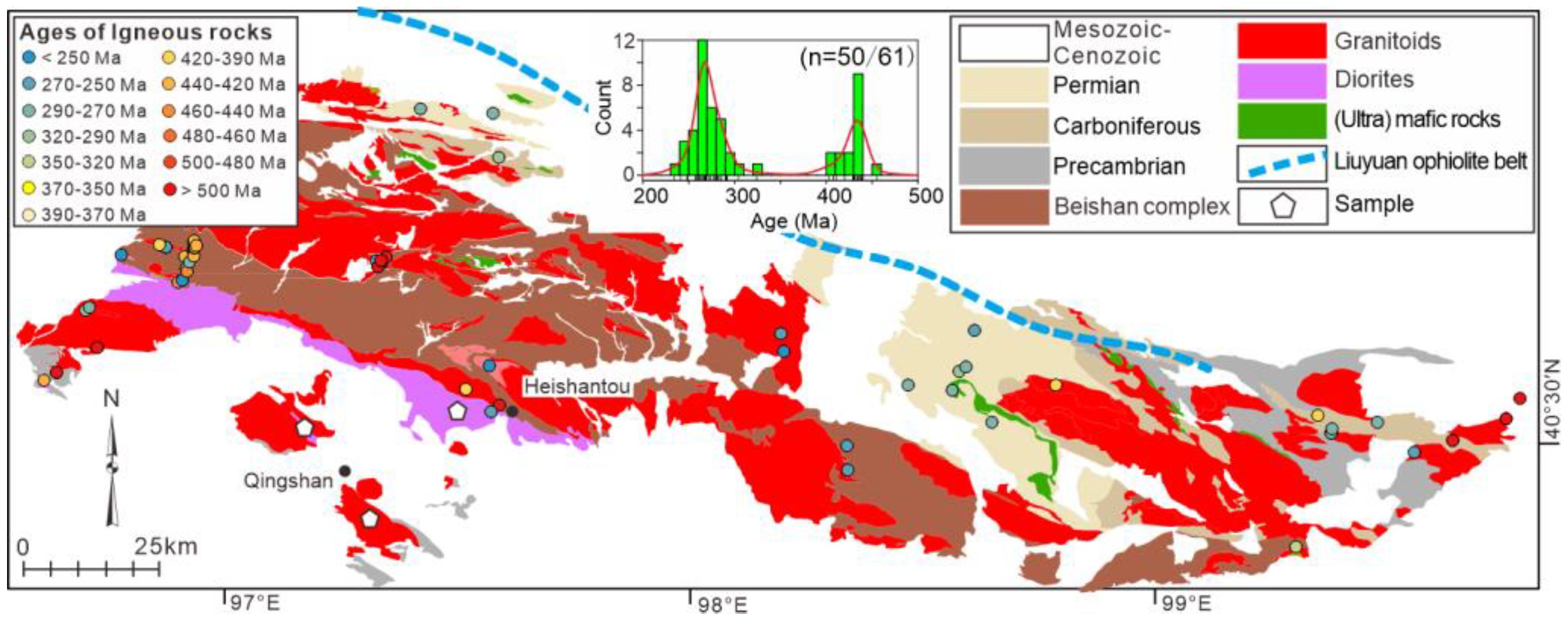
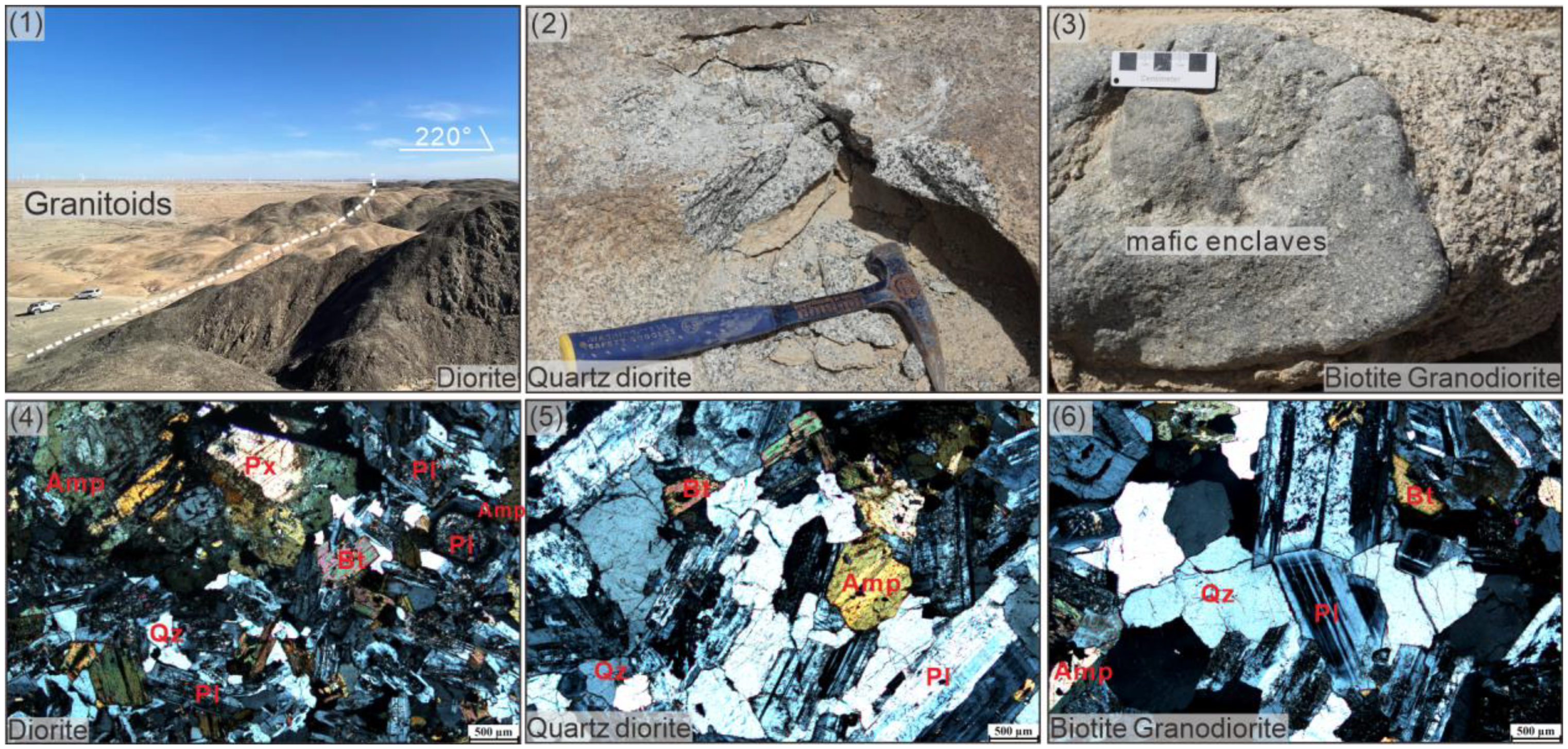
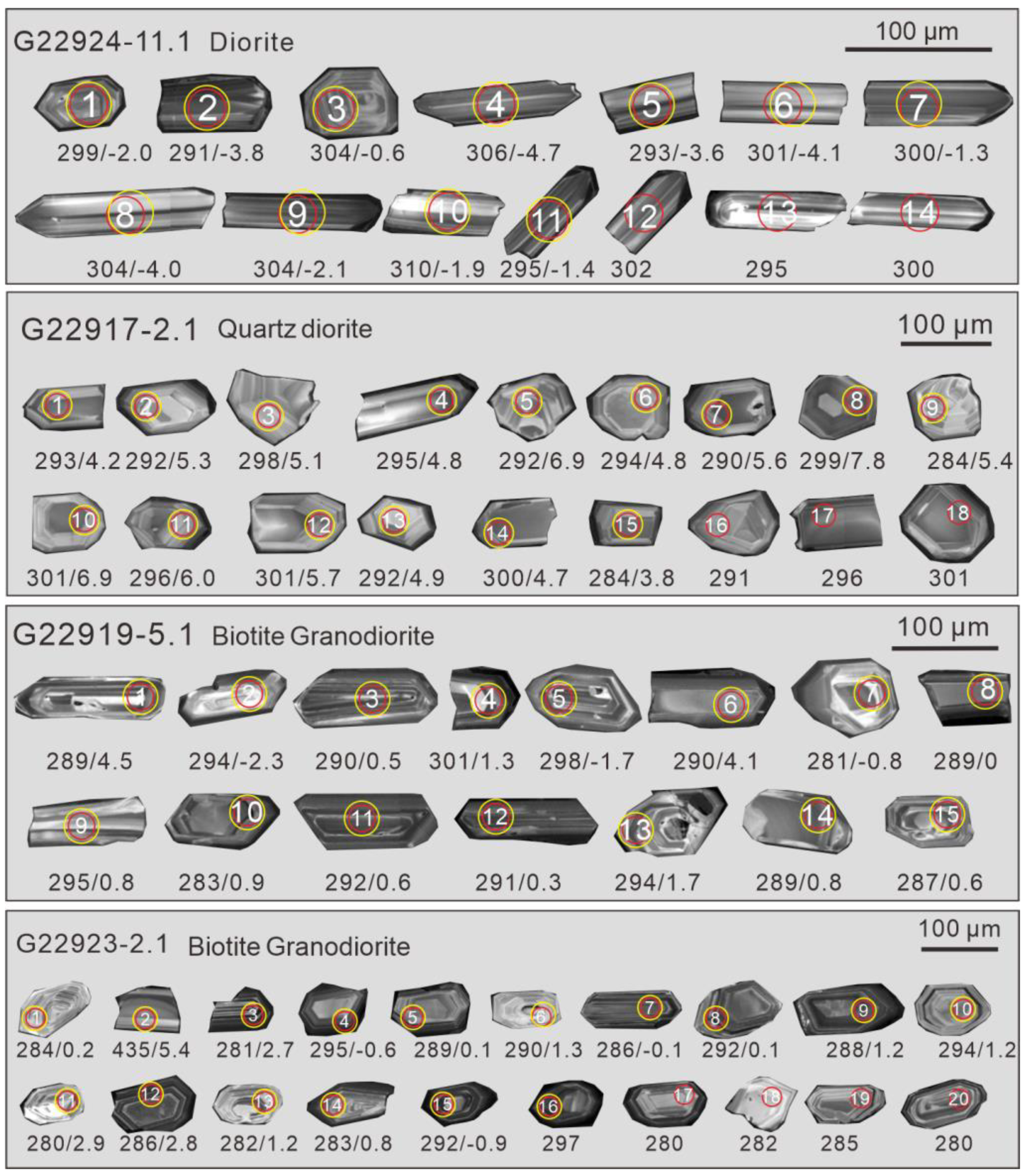

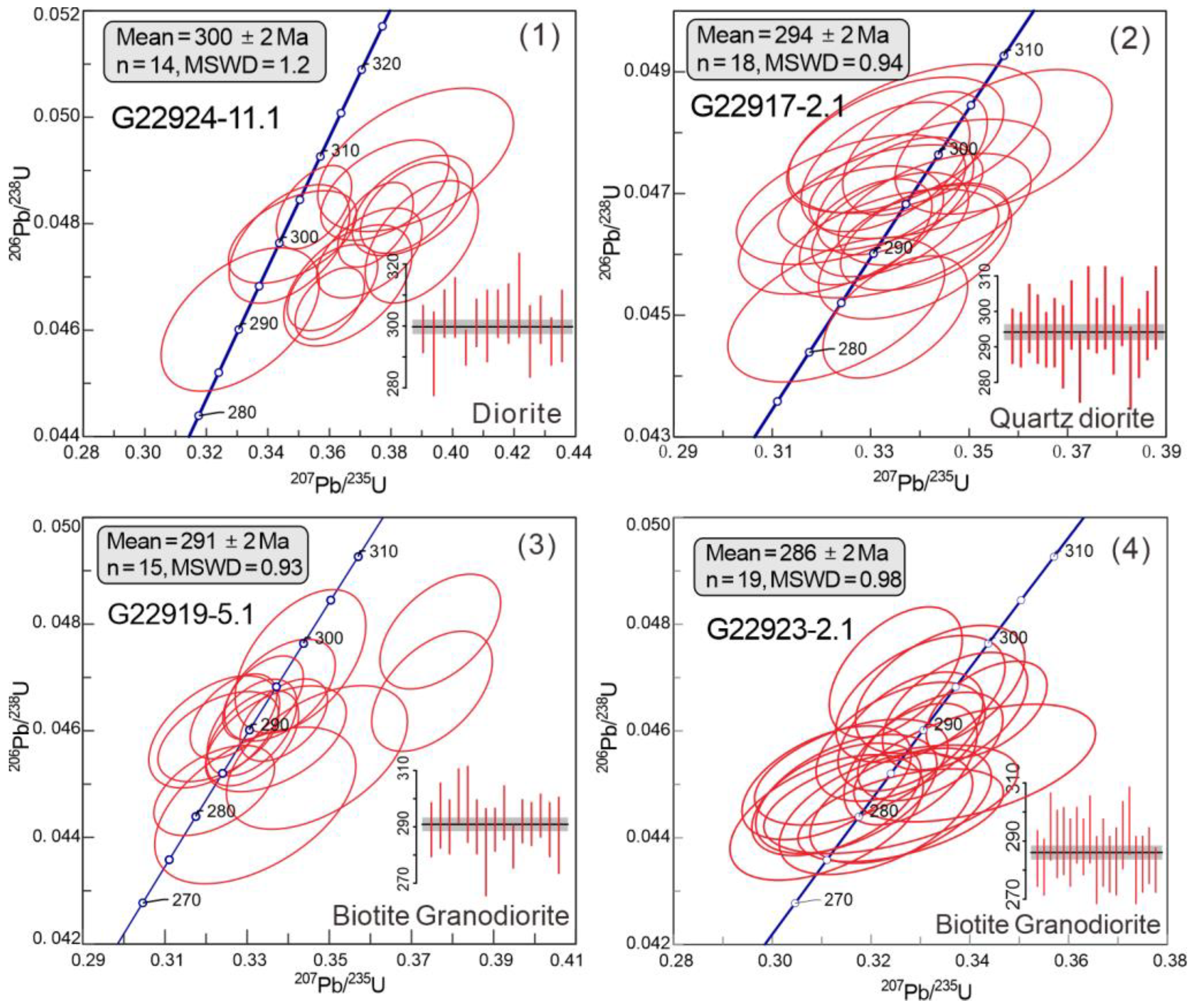

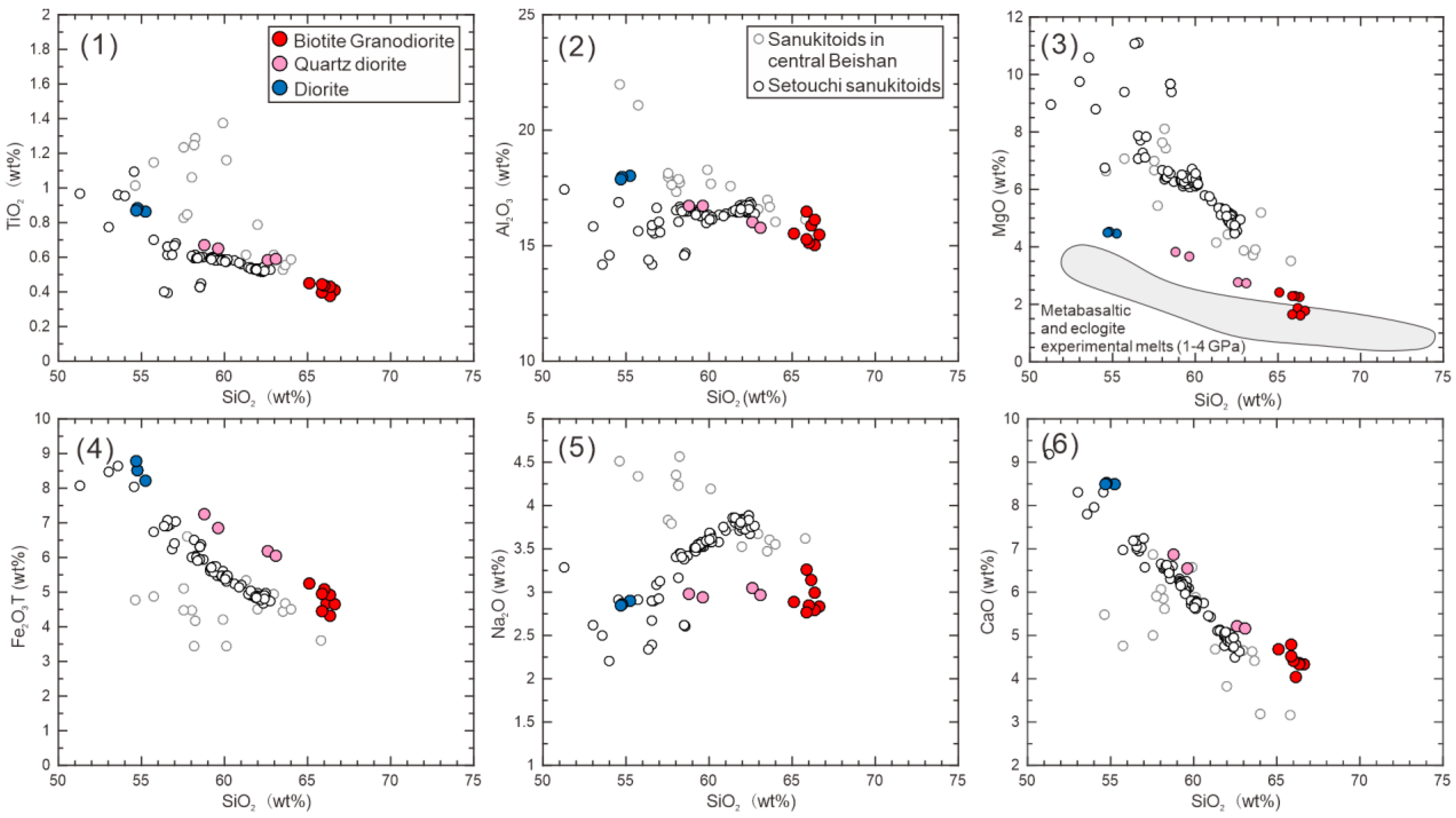
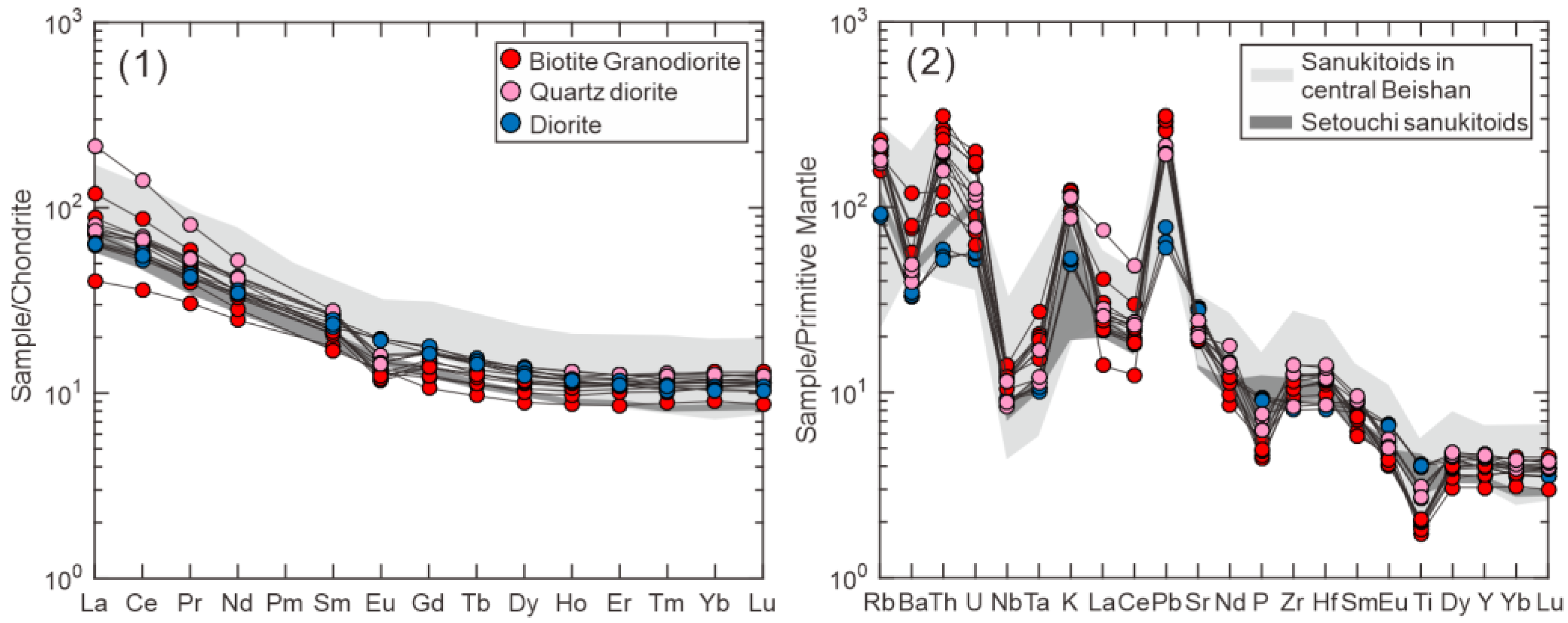


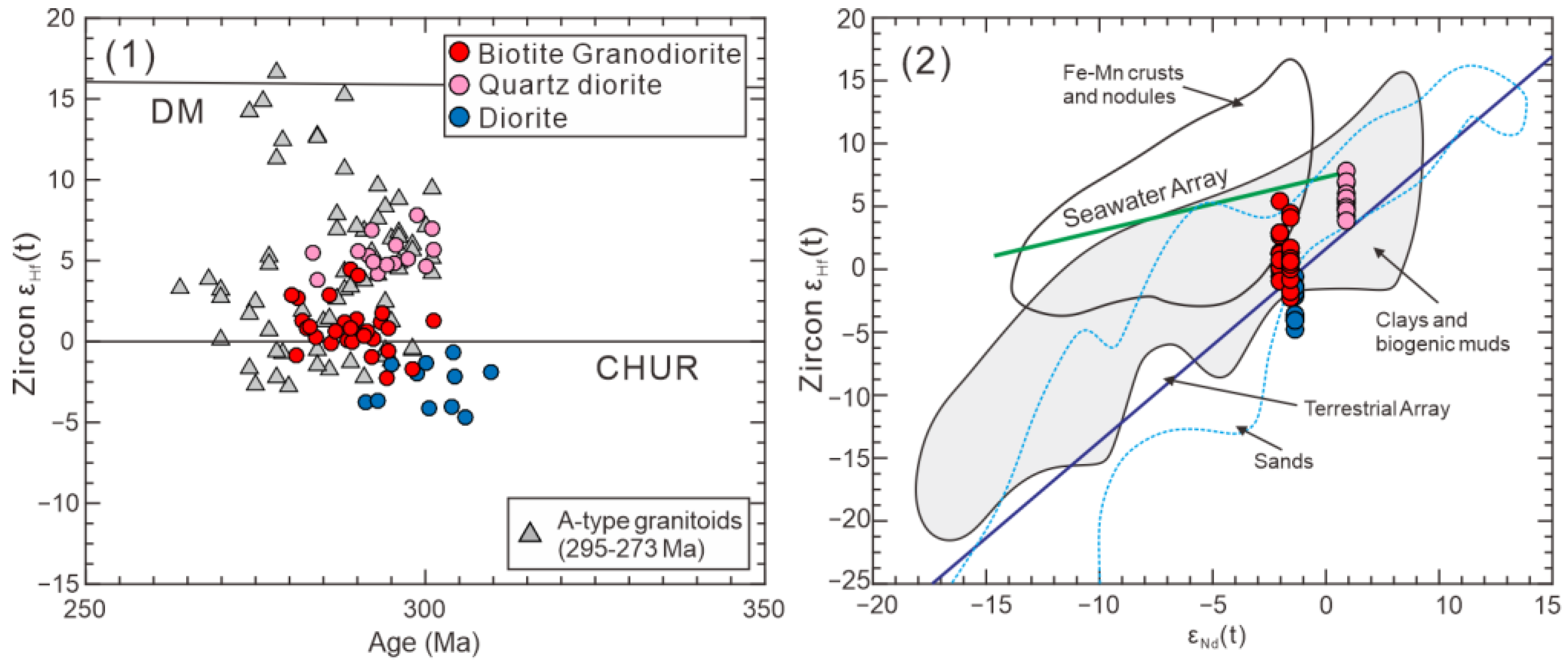


Disclaimer/Publisher’s Note: The statements, opinions and data contained in all publications are solely those of the individual author(s) and contributor(s) and not of MDPI and/or the editor(s). MDPI and/or the editor(s) disclaim responsibility for any injury to people or property resulting from any ideas, methods, instructions or products referred to in the content. |
© 2024 by the authors. Licensee MDPI, Basel, Switzerland. This article is an open access article distributed under the terms and conditions of the Creative Commons Attribution (CC BY) license (https://creativecommons.org/licenses/by/4.0/).
Share and Cite
Li, R.; Su, S.; Sun, H.; Liu, R.; Xia, Y. Petrogenesis and Tectonic Significance of Early Permian Intermediate–Felsic Rocks in the Southern Beishan Orogen, Northwest China: Geochronological and Geochemical Constraints. Minerals 2024, 14, 114. https://doi.org/10.3390/min14010114
Li R, Su S, Sun H, Liu R, Xia Y. Petrogenesis and Tectonic Significance of Early Permian Intermediate–Felsic Rocks in the Southern Beishan Orogen, Northwest China: Geochronological and Geochemical Constraints. Minerals. 2024; 14(1):114. https://doi.org/10.3390/min14010114
Chicago/Turabian StyleLi, Runwu, Shangguo Su, Huiyi Sun, Ruibin Liu, and Yutian Xia. 2024. "Petrogenesis and Tectonic Significance of Early Permian Intermediate–Felsic Rocks in the Southern Beishan Orogen, Northwest China: Geochronological and Geochemical Constraints" Minerals 14, no. 1: 114. https://doi.org/10.3390/min14010114




